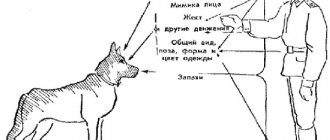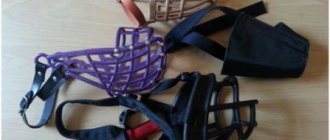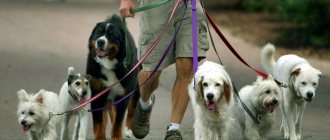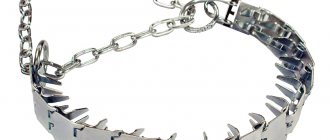Many dog owners underestimate or completely ignore such an important thing as a muzzle. In fact, this is an integral part of the equipment, the same as a collar, harness, or leash. A muzzle helps solve the problem of aggression, transportation of animals in public transport and over long distances. Such a simple thing can save your pet’s life if he likes to pick up everything from the ground. How to accustom a dog to a muzzle so that it calmly reacts to it when it needs to be put on? Especially if it is a puppy or an adult dog? Let's figure it out.
Which breeds require a muzzle?
There is a list of potentially dangerous breeds for which wearing a muzzle is mandatory, regardless of the owner’s wishes. Without it, dogs can only stay in a closed area that belongs directly to the owner of the animal. In addition, there must be a warning sign indicating the presence of a dangerous dog behind the fence. The Law “On the Responsible Treatment of Animals” includes the following in the list of dangerous breeds:
- American Bandoggy Mastiff;
- American Bulldog;
- bully kutta (Indian or Pakistani mastiff);
- Brazilian Bulldog (Campeiro);
- Pakistani bulldog (gul dong);
- North Caucasian dogs (Caucasian, Central Asian Shepherd);
- wolf-dog hybrids (Czechoslovakian wolfdog, Saarloos wolfdog, Kunming shepherd dog);
- Turkish Akbash;
- Alapaha Bulldog;
- mestizos and hybrids of the above breeds, aboriginal breeds and those involved in baiting.
This list does not relieve owners of all other dogs that can cause harm to humans or other animals from liability.
How to put a muzzle on a dog
First of all, let's figure out at what age to wear a muzzle . Usually, a puppy begins to be accustomed to a muzzle at 5-6 months. If you missed this period, and now you have an adult dog in front of you, then it’s okay - the training scheme is the same for both kids and adults.
At the first stage of training to use a muzzle, you just need to show it to your pet and let him smell it . Let the dog calmly get acquainted with the new thing and understand that it does not pose a threat. At the same time, do not allow it to be chewed or scratched with your paw. After your pet calmly sniffs the item, praise him.
Next, show the dog a piece of the treat and insert it into the muzzle so that the dog has to push its muzzle all the way in to get it. At this stage, do not try to fasten the muzzle; your pet should be able to freely free himself after receiving the treat (otherwise he may get scared). Repeat this exercise several times so that your pet is completely accustomed to the new equipment and can stay in it for a couple of seconds.
Now proceed as described above, but do not give the treat right away . Wait 2-3 seconds and then release your fingers and allow your dog to receive the treat. Repeat the exercise, gradually increasing the time between giving treats. If your dog remains muzzled after receiving food, be sure to reward this behavior.
When the dog learns to remain in the harness for up to 7-10 seconds, you can begin to fasten the straps. Praise and treat your dog for staying calm with the muzzle fastened.
To help your dog develop a positive attitude towards the muzzle, wear it briefly before feeding or walking. If you see that he is trying to remove the item, distract him with a game or just ask him to run. When he behaves calmly, actively praise and treat him. Do not remove the muzzle at the moment when the dog is trying to do it himself, wait until he is completely captivated by something else and only then remove it.
How to put on and when to take off
A dog should be accustomed to a muzzle gradually, day after day allowing the animal to get used to an unknown object. As in any training, a strict sequence of actions is required, the formation of positive associations and consolidation of the result.
Introducing a new accessory
Use a favorite food or treat for your pet's first introduction to a scary object. Before feeding, put a small amount of food or any other food into the muzzle and invite the dog to take it out. Place the tidbit from the very edge the first time, and then each time deeper until the dog sticks its muzzle completely into it. Repeat the action until the dog is no longer afraid of the muzzle, and only then try to fasten it. Leave the muzzle on the dog for a short time.
Consolidation
When the dog is no longer afraid to put on a muzzle and allows you to do it without bait in it, be sure to praise him and treat him with something tasty. Slowly increase the time between putting on and giving the treat. This will allow you to soon completely refuse rewards in the form of food.
Positive associations
How to train a dog to wear a muzzle quickly and effectively? It should evoke only positive emotions and associations with your favorite activity in your pet. Almost all dogs love walks. Try to form a strong connection in your pet between putting on the muzzle and the subsequent walk. But don't rush. First, let the dog become familiar with the equipment, sniff and inspect it thoroughly. Repeat the action before each walk, reinforcing the habit.
How to choose a suitable muzzle for a dog?
Do not buy a muzzle from an online store. You won't be able to find one remotely. The best solution would be to go with your dog to the nearest pet store and try on the muzzle in person.
Don't try to find the perfect muzzle that your dog will love. This won't happen. This item is restrictive and will not please your pet anyway. Try to find a muzzle in which the dog will be as comfortable as possible, he will be able to stick out his tongue, and most importantly, he will not be able to remove it.
Then everything depends on the breed, size and aggressiveness of the dog. A nylon muzzle is used for small breeds, a mesh muzzle is used for all breeds, and a completely covering muzzle is used only for training.
How to choose ammunition
When choosing such an important thing for your pet, you must be guided first by its safety and convenience:
- plastic muzzles are convenient for training, but break quickly and are not suitable for cold or too hot weather;
- metal muzzles are not suitable for use in the cold season, they can rub or be too heavy for the pet;
- a solid muzzle made of synthetic materials or tarpaulin can chafe, impede normal breathing, disrupt thermoregulation in hot weather (the dog cannot breathe normally and open its mouth), and are not suitable for training;
- Preference should be given to lightweight, durable products made from strips of natural leather in the form of a lattice, which allow normal breathing and taking treats during training.
To choose the optimal size, you need to ensure that the equipment is not too large or tight. It’s good if you have the opportunity to try on several different ones immediately before purchasing.
How to choose the right muzzle and what types exist?
Muzzles differ in materials and mounting options. In general, they can be divided into four groups.
- Fully covering muzzle Made of leather. He closes the dog's mouth tightly. Such muzzles should not be worn on a regular basis, as they do not allow the dog to breathe through the mouth. Which in turn causes discomfort and can lead to fainting. Such muzzles are used during training and search operations (search for narcotic drugs).
- Lightweight mesh muzzle. Excellent option. In such a muzzle, the dog can breathe through its mouth and drink. It doesn't cause much discomfort. They are made from leather, fabric, metal using mesh material. Don't forget, the leather and fabric absorb saliva, which leads to the muzzle icing up in cold weather. You should also use metal muzzles with caution in cold weather. Your pet's tongue may freeze to the metal. You should not buy a plastic muzzle for a large dog. It may not withstand the load during aggression. Don't buy products that are too cheap. As a rule, they use low-quality materials.
- Muzzles made of nylon and fabric The cheapest and simplest muzzles. This is a Velcro strip that tightens the dog's face tightly. Such muzzles will not help if you have a large breed of dog. They should not be used for a long time, as the dog will not be able to breathe through the mouth and drink. It will be uncomfortable to walk in it due to squeezing of the nose, which leads to problems with charm.
- Special muzzle for flat-faced breeds If you have a pug or a bulldog, then a special muzzle has been developed for this breed. It looks like a helmet and fits on the dog's head. It is made from leather, or fabric.
For what purpose does a dog need a muzzle?
Any dog, regardless of its size, in some cases needs to wear a protective item. Thus, it is worth highlighting the most common situations of such urgent need:
- A dog like a Labrador, which is very large in size, should not be walked in public places without proper protective equipment. Although this particular breed is quite friendly, this does not mean that the puppy will not want to frolic and grab the pant leg or bite a passing person.
- Large specimens always cause fear among passers-by. It is also very important to note that the owner is not always able to predict the mood of his pet. Consequently, the need for this protective item here is very difficult to overestimate. If you properly muzzle your dog, this can maximally prevent it from attacking or any inappropriate reaction.
- Even if you have a small dog, when visiting the veterinarian you should not forget about such a protective accessory as a muzzle. Even the friendliest pet can react with unpredictable aggression to an injection or touch from a stranger. Thus, how to accustom an adult or young dog to a muzzle should also not go unnoticed by the owner.
- If you are going to transport your pet on public transport, you will definitely need to get a protective muzzle. This is due to the fact that most carriers simply prohibit transporting dogs without protective accessories.
- It is necessary, first of all, to accustom your pet to wearing ammunition because it is necessary to preserve its health and life. While walking, a shepherd dog can pick up something from the ground and get poisoned. Some evil neighbor may poison the yard dogs, and your pet will become his victim. The consequences of such poisoning can be very unpredictable, therefore, it is best to be careful and put on a protective device for the dog.
Briefly about the main thing
- The pet products market offers a wide range of products made from various materials: plastic, metal, leather, fabric (nylon), muzzles and halters.
- In order to protect others or the pet itself from being picked up on the street, it is recommended to choose durable products that completely cover the mouth. Leather, metal or plastic models are suitable.
- If you need equipment for visits to the veterinarian, you should purchase a cloth muzzle.
- To be with your pet in a public place or transport, you can safely purchase a halter.
- In order not to make a mistake with the size of your purchase, you should come to the pet store with your pet and try on the item directly there. The product should be tightly fixed on the animal’s face, but it is necessary that the dog has space around its mouth so that it can breathe freely with its mouth slightly open.
- The animal must be accustomed to equipment from any age. The earlier the better.
- You need to accustom your pet to the product smoothly and carefully, with the help of treats. First, present the item to the animal's face, then bring the item closer and closer, eventually finally placing it on the pet's face. All actions should be supported by a treat. Remove the product only when the dog is calm. If your pet tries to remove the muzzle, wait until he stops doing so, then give the animal a treat. Associate the pet's product with a positive thing.
We hope that the article was useful to you and that you learned a lot of useful information regarding muzzles. We wish you good luck in choosing and using ammunition for your four-legged friend!
How to muzzle a dog can sometimes be daunting for an owner. First of all, this is due to the incorrect choice of this protective accessory. In addition, very often the dog simply does not want to be restrained by anything and may simply resist and refuse to wear this device.
Common mistakes
- Forcibly pushing an animal's muzzle into a muzzle . In order for the dog to have a positive attitude towards the product, only with the help of a treat force it to pull its muzzle into it. Under no circumstances should you put on a muzzle against the will of the animal, otherwise in the future the pet will resist the product even more.
- Abrupt transitions from stage to stage . Accustom the animal to the muzzle smoothly and carefully. You should not rush in this matter if you do not want the dog to resist the ammunition.
- Rare reward with a treat . The pet should associate the muzzle in his head with something pleasant. To do this, reward your dog a little, but often. Try to give your dog treats directly through the muzzle.
- Punishing a pet for trying to remove ammunition . If you punish your pet for trying to remove the product, the dog will treat it even more negatively than before. In addition, your contact with the dog will deteriorate. Try to correct the problem exclusively through a positive impact on the animal.
Stages of training a puppy or adult dog to use a muzzle
- Take a treat and show it to your pet. Place the muzzle on the animal's face without putting it on the dog, and give the pet a treat. Repeat this several times.
- Present the product so that it covers a small part of the animal's muzzle, then praise the dog. Repeat several times.
- Place the harness on half of the animal's muzzle, then give the dog a treat. Next, you can hold the muzzle in this position for a few seconds. Don't forget to praise the animal.
- Place the muzzle completely on the animal's face without fastening the fastening straps, and then give the pet a treat. Repeat this several times, and then begin to hold the product on the animal’s face for a few seconds.
- Place the product completely on your dog, fastening all the fastening straps. After a few seconds, remove the muzzle and give your pet a treat. Repeat this several times.
- Increase the amount of time your pet is muzzled. You can give your pet treats without removing the product through the hole in the muzzle.
- During walks, if the dog does not try to remove the equipment, periodically praise the animal with a treat.
Types of muzzles
Plastic
The model is made of plastic intertwined rods. The product is lightweight and quite durable.
After a walk, the plastic can be easily washed off from dirt. Due to the wide rods and the space free from the mouth (if the size is chosen correctly), the dog can easily open its mouth, which is very important for cooling the body in case of overheating.
The model will prevent the animal from trying to pick up something from the ground.
You should be careful when using a plastic product in winter, when exposed to frost: the material may crack.
The model is suitable for dogs of small, medium and large breeds.
Leather
The product consists of intertwined leather rods in the form of a mesh, which are secured to each other using metal inserts.
The model is predominantly light, due to which the dog is not only more comfortable using it, but also on walks, especially if the pet is not overly careful; in case the dog bumps into your legs or touches your legs with its muzzle, the product will not cause you additional pain.
In such equipment, the dog will not be able to pick up anything from the ground. The leather model is durable.
Such a thing requires some care, otherwise the model will become stiff and unusable.
Also, when washing leather, you will need to dry it, unlike plastic or metal materials, which can simply be wiped with a dry cloth.
The leather model is suitable for pets of large and medium breeds.
Metal
The model is made of iron intertwined rods in the form of a mesh.
This product is very durable. The dog will not be able to pick up anything from the ground wearing such equipment. Also, the animal can easily open its mouth, and in the heat it will not be difficult for it due to this.
The product is quite heavy, and therefore your pet can hurt you if it accidentally bumps into you and hits you with its muzzle.
After a walk, the metal can be easily washed and wiped with a rag. The model is suitable for dogs of large and medium breeds.
Fabric
The model is a sewn nylon fabric that fits tightly to the dog's face. The nose and the space around it remain open.
Fabric ammunition is very light.
Since the pet cannot open its mouth with this product, it is highly not recommended to use it in the heat or give the animal physical activity - this is fraught with bad consequences.
It will be difficult for your pet to pick something up from the ground, but it is possible. The dog can at least lick the edible food. Such ammunition is not durable. After walking and washing the product, you will have to dry it.
The model is suitable for dogs of small, large and medium breeds.
Halter
The model consists of several sewn fabric strips with a ring for attaching a leash.
Such ammunition is not suitable for aggressive dogs or animals that have problems picking up from the ground, since the pet will be able to easily move its mouth in it.
The halter is adapted to attach a leash to it; the dog, due to the design of the product, stops pulling and walks on a sagging leash.
The model is difficult to get dirty, but after a walk it can be washed with water and needs to be dried.
The halter is suitable for dogs of medium and large breeds.











